
|
||
|
Portland art blog + news + exhibition reviews + galleries + contemporary northwest art
|
||
Bridging some gaps in the discussion  Architect Donald MacDondald's "Refined" Cable Stay design, up for review today Once again, discussion of the Willamette River Transit Bridge has heated up in anticipation of today's meeting for the final choice of bridge type. In my opinion it isn't bridge type that matters... it is the detailing of whatever design chosen that will determine how usable, environmentally sensitive, pride inducing, and ultimately successful the design will be. To bring everyone up to speed... PORT pretty much started the civic discussion over this bridge with our totally unofficial design competition, later we broke the images of the rather nice hybrid design that now seems out of favor with the committees. Frankly, I like pure cable stayed designs, they have generally cleaner lines and can span longer distances which can make for a smaller environmentally footprint... but the details have to be good and the discussion around them needs to be relevant to produce sensitive designs. The stakes for this project are huge. In many ways Trimet and Portland's alt-city reputation as a green, civically progressive oasis in America is on the line. It's understandable but should Trimet really try to come in way under budget on what will likely be their most visible project ever? Answer is yes and no of course... If the bridge fails as a pedestrian and cycling bridge it will be seen as a huge waste. If its design is clunky it will be a constant embarrassment. Yet I can see Trimet's penny pinching stance... if this thing costs 15 million more than it is supposed to it will be a lightning rod for critics... do they risk it? Currently only 1 design (the tall cable stay) is sub-par but that can be fixed... and it better be if chosen today. To catch everyone up more; last week Portland Architecture took on the O's rather stilted analysis of the situation. The problem being that the O (which quite obviously doesn't have an architecture critic but needs one for legitimacy sake) continues to demonize design as an expensive luxury, when in fact it's all about making certain the public is getting the most for their money. Sorry, but Rivera (a fine writer) is totally out of his depth here (though Im glad the O is paying attention). In fact, none of these designs is terribly ambitious in terms of being a truly signature design. Technically, the hybrid was a mildly ambitious design that was more refined than a ballsy solution. It was a pretty sane proposal that still made Trimet uncomfortable price wise. Some have even called the Hybrid bridge a Mercedes but really the more accurate comparison is more like a Honda Accord instead of a Civic or Fit... Granted Rosales' "Hybrid Accord" was a fully loaded model with nice detailing. Hopefully the official architect Donald MacDonald's finished design can equal or better the Rosales details below: 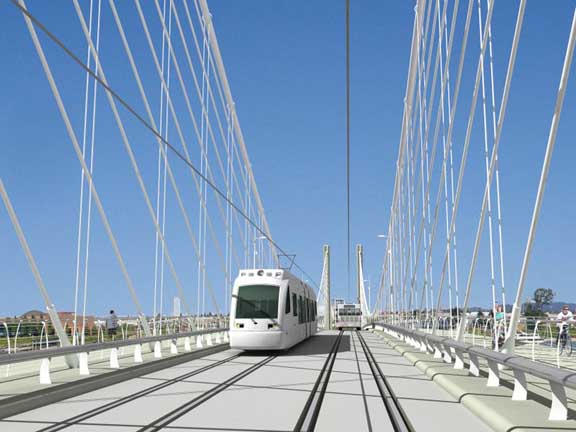 Pedestrian view from proposed "Hybrid" bridge, courtesy Rosales + Partners/Schlaich Bergermann and Partner LP This bridge will be the first pedestrian and transit only span of its type to be built in this country but the question is will any the revised cable stay design (let's call it the "V") actually well suited to the pedestrian and cyclists who are supposed to use it (more on this below)? Whereas the out of favor hybrid design is specifically tailored to improve the pedestrian and cyclist's experience? This isn't so called "fancy" design folks, it's a basic utilitarian question so characterizing this as a more trivial design consideration isn't sound logic and does a disservice to the community). We should make certain this bridge will be used for the purpose it was built; transit, pedestrians and cyclists. Also, I can see where Barry Johnson is coming from here... but he's just dead wrong. Size of the bridge towers doesn't matter if it is done well. Size isn't the bogeyman... bad design is. If the towers are inspired they stand out in a good way. The problem is all of the large cable stay towers we have seen have been pathetic designs... so yeah I'm with you Barry if that is what they are going to build (ps that isn't a Rosales designed cable stay you have pictured, he pretty much refused to do any cable stay designs and I suspect Trimet and Rosales were just plain sick of each other... neither side seemed to give much). Here are my thoughts on the 3 designs: 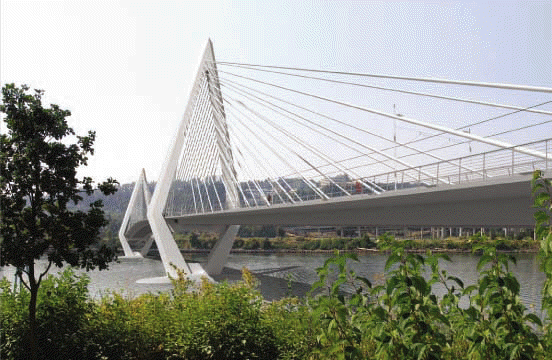 This cable stay design is very unrefined and clunky, height isn't the problem, it's the bad tower design and details. This could be improved significantly Standard Cable Stay: I've already stated that this design is just too clumsy... and though this is the leading contender (because of price) we haven't seen any new designs for a tall cable stay. Initial consulting architect Miguel Rosales repeatedly demonized the height of the cable stay designs and put all of his bets on a hybrid cable stay and suspension design and lost out due to cost concerns (though the Hybrid is a good design). I wonder why he didn't design any more refined cable stay options. Also, why are all of the towers either forked or A frames? What about a single elegant center post design like Millau etc? It would be more transparent... but I suspect it would be a lot taller. 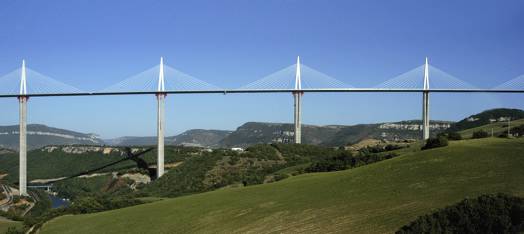 Sir Norman Foster's Millau Viaduct, sets the high bar for high-use elegant cable stay design. Still, if it is an elegant symbol of mass transit and a more environmentally responsible world why not have such a soaringly transparent symbol? It might even save money. Stop yummering over size and focus on quality in a heuristic way. It is entirely possible for a very tall tower to be very sensitive and inspiring... maybe even more cost effective! Good design doesn't have to be more expensive... simply spend a little extra on better detailing and some unique features that improve the basic cable stay design and viola, everyone wins.  Hybrid cable stay/suspension design... a modern, yet anachronistic... but reserved design Hybrid Suspension / Cable Stay: This is a nice (reserved) European looking option. It is hardly ostentatious as some have called it and a lot is made of the swooping caternary cable between the towers. Frankly, I think the anachronistic look back at the St. Johns Bridge (the 2nd best bridge on the West Coast) doesn't make much sense, but the swooping aspects do soften the bridge's effect on Portland's skyline and blends in with the west hills etc. Rosales originally proposed this design but the now architect of record Donald MacDonald could still do it. Honestly... I can see a more refined cable stay beating it out. Why spend more to be anachronistic... especially if the architects gave changed. I doubt Donald MacDonald has any real feel for this design, its just on the plate because some love it. I merely like it. 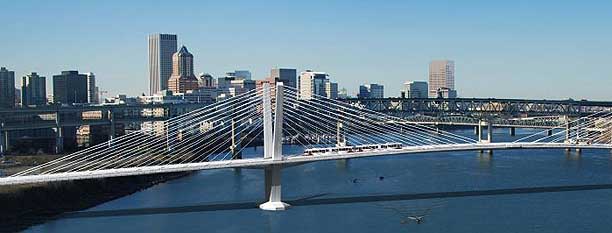 Detail of V design "Refined" cable stay option... It's definitely bolder than the "Hybrid" from a distance Refined Cable Stay: Well I do like this a lot better than the clunky travesty that is the "unrefined" or standard cable stay. "Refined" is code for "shorter towers". But frankly its the fact that the V towers are a lot nicer than the clunky "A" towers that gets my vote. It is also bolder looking than the Hybrid. Still I wonder if this is really is the best option... if Trimet went with the possible "H" towers (also mentioned May 28th) it might lose all of the open airiness and boldness. Also, there is the problem of its appropriateness for pedestrians and cyclists... would their use lanes be on the outside of the cables and wouldn't the leaning umbrella effect provide birds with a platform from which to scatter their droppings upon those users? It's just a concern. If the pedestrian and cycle lanes are on the inside of the V's with the buses and trains it wont be as pleasant either. The separation between the transit vehicles on the Hybrid design and the standard cable stay wins in use terms for pedestrians and bicycles. 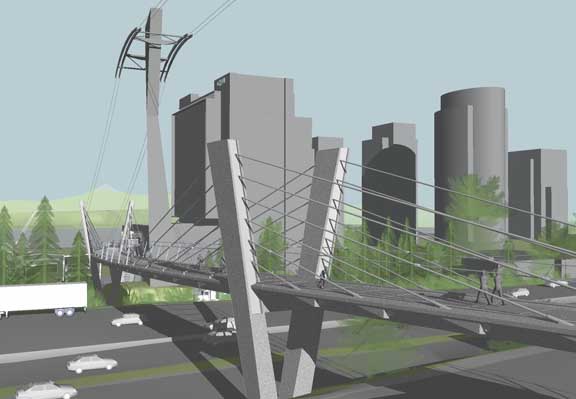 Gibbs street pedestrian bridge with "V" design Also, though I rather like the V tower design... I can see where having something smaller but similar for the Gibbs street pedestrian bridge by the Aerial Tram will create a bit of design confusion in terms of landmarks. Then again that redundancy might be good and by repeating the V design throughout Portland it creates a sense of aggregate uniqueness. Both are intended pedestrian use and the "V" could symbolize victory over the car culture. My prediction is either a refined cable stay or standard cable stay... and if either is built the art and design community should really press for the best details possible, that's towers and ped/cycle lanes etc.. the whole shebang. PORT readers should contact Trimet with your concerns. Most importantly There will be two design workshops in July on the 2nd and 24th. The art/design community should be out in force for those meetings and we will want more detailed images of the proposed design to consider. *Side Note: the Columbia River Crossing still requires a major design competition as PORT was first to call for... if there isn't one the project should be stopped momentarily rather than build the wrong bridge. We still need the CRC but it requires a far better level of understanding (from all sides) than I've seen up to this point. *Update: as anticipated Trimet chooses the refined cable stay V or H option Posted by Jeff Jahn on June 22, 2009 at 11:00 | Comments (0) Comments Post a comment Thanks for signing in, . Now you can comment. (sign out)
(If you haven't left a comment here before, you may need to be approved by
the site owner before your comment will appear. Until then, it won't appear
on the entry. Thanks for waiting.)
|
| s p o n s o r s |
 |
 |
 |
 |
 |
 |
 |
 |
 |
 |
 |
 |
 |
 |
 |
 |

|
Site Design: Jennifer Armbrust | • | Site Development: Philippe Blanc & Katherine Bovee | |

